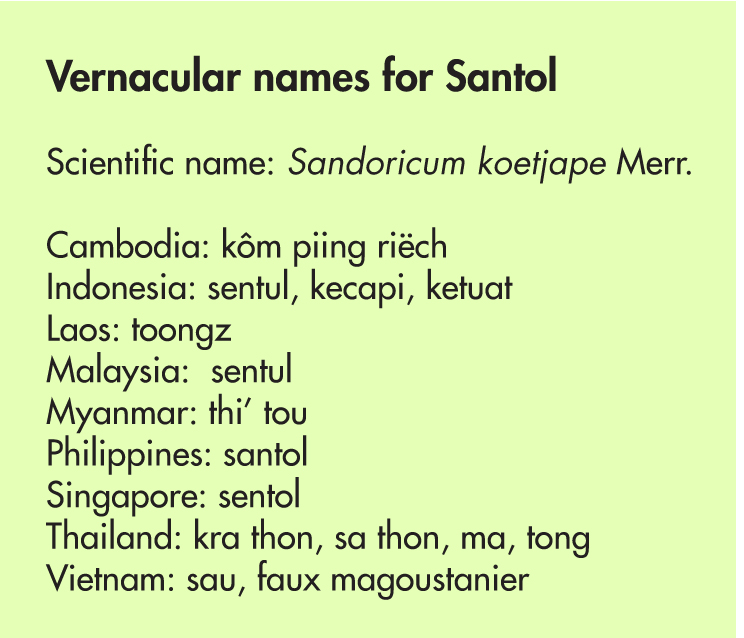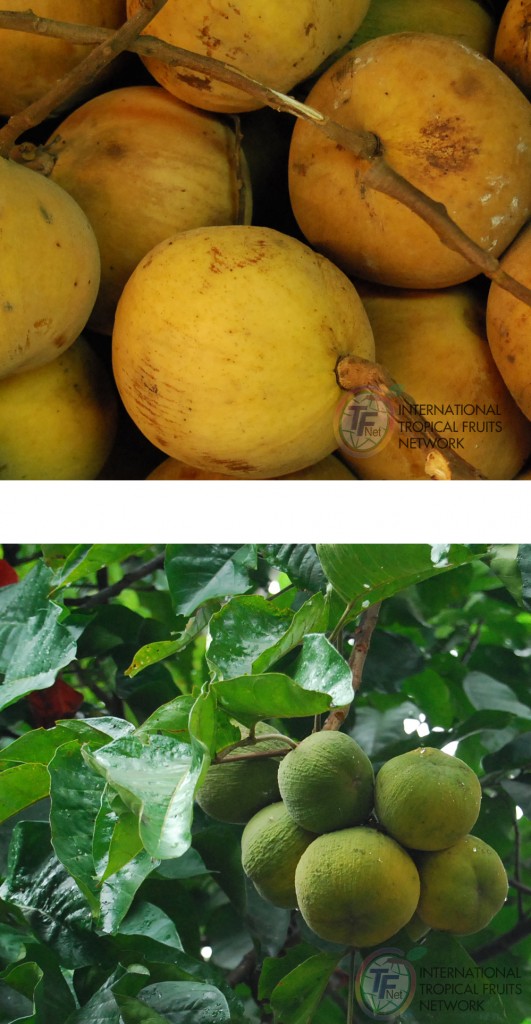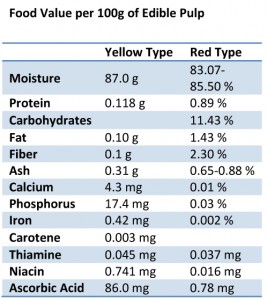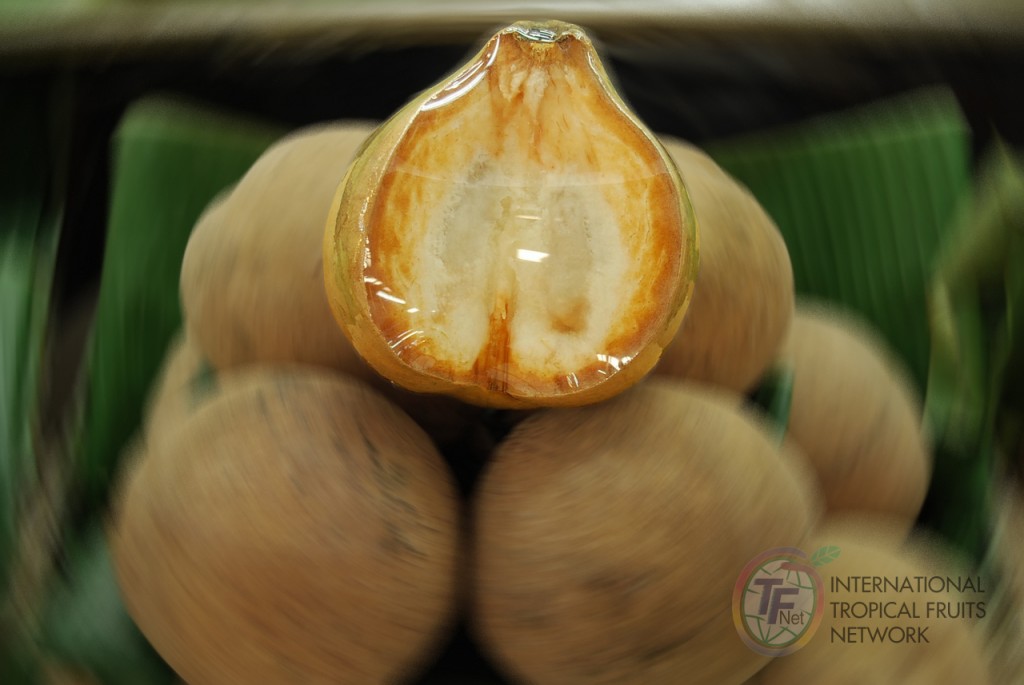 Known for its rich, sweet, tart, and creamy taste, santol is commonly consumed in the Philippines and Thailand. It is mostly eaten fresh – one has to suck on the thick flesh covering the seed to get the flavor. However, the fruit’s real potential lies in processing of its thick pulp to export-quality candy, jam, jelly, or chutney. It also has inherent medical uses and has been found to be a possible cure for cancer.
Known for its rich, sweet, tart, and creamy taste, santol is commonly consumed in the Philippines and Thailand. It is mostly eaten fresh – one has to suck on the thick flesh covering the seed to get the flavor. However, the fruit’s real potential lies in processing of its thick pulp to export-quality candy, jam, jelly, or chutney. It also has inherent medical uses and has been found to be a possible cure for cancer.
Santol (Sandoricum koetjape Merr.), together with Langsat, is one of the only two edible fruits in the family Meliaceae. It is a native to former Indochina and Malaysia and is now found in most tropical countries across Asia. There are 7 species under the genus in India and Malaysia while 2 are in the Philippines. In the western hemisphere, a few specimens have survived in Honduras, Costa Rica, and the American states of Florida, Miami, and Hawaii. Other territories remain undocumented.
The santol is a medium to large-sized tree that grows vigorously to 15-25m, branched close to the ground and buttressed when old. Trunks can reach a diameter of 80cm or more. Soft hair grows on leaves and young branches. The tree is evergreen but can be considered partly deciduous since it periodically drops all of its leaves at a single time.
The compound leaves, with 3 leaflets, are alternately arranged in a spiral pattern around the shoot. They grow up to 20-25cm long, elliptic to oblong-ovate in shape, pointed at the tip and rounded at the base. The leaves are light-green when young, dark green when mature, and red or yellow when about to fall. The upper surface is shiny but dull and hairless underneath.
The flowers of the santol are branched in a cluster (called panicle) and form near the shoots. Each panicle is about 15-30cm in length while individual flowers are 1.3cm wide and 1.0cm long. The 5-petalled flower has a mild scent and its color varies from shades of green, white, and yellow.
Technically a capsule, the fruit is round to oblate in shape and flattened at the base. It is green when immature and turns yellow to golden with occasional blushes of pink upon ripening. The outer covering is thick, tough, and leathery pericarp or edible pulp that contains a milky edible sap. The inner fleshy portion consists of a white, translucent, somewhat fibrous, and juicy pulp that adheres to the seed. When eaten raw, the pericarp is sour and mildly acrid while the fleshy pulp at sweet and slightly tart. Each fruit contains 3-5 inedible seeds that can be up to 3cm long that contains an embryo of 2 cotyledons.
Varieties
The leaves of santol change to either red or yellow as it gets old, which determines plant variety. The leaves and the pinkish-yellow panicles of the Yellow variety are about 15cm long. The fruit has a thin rind and the fleshy pulp is 0.6-1.25cm thick around the seeds. On the other hand, the leaves and the light green panicles of the Red variety are about 30cm long. The fruit has a thick rind of about 1.25cm and the fleshy pulp around the seed varies. The fruit of the Red variety always falls when ripe. In 1958, Philippine researchers documented a santol tree whose fruits remain green even when ripe. The fruit produced are strongly sour.
Soil and Climate
The santol can thrive in any kind of soil, provided it is well-drained. The tree has been documented to grow well in Florida in acidic sandy soil. However, it grows best in very loose and deep soil with plenty of organic matter.
The tree is very hardy and grows vigorously in both dry and humid regions of the tropics. However, it does not grow well on areas 1,000m above sea level. It grows best if rainfall is well-distributed.
Propagation
There are many ways to propagate santol: seeds, inarching, marcotting, grafting, and budding. Using seeds is not recommended because there’s a high likelihood that the plant will yield sour fruits. Inarching is the easiest method of asexual propagation but is seldom used. Marcotting is also not recommended since it takes 5-6 months before the marcot can be removed from the mother plant.
Grafting is the most reliable method for large scale propagation of outstanding trees. Seedling rootstocks should be about 1-2 years old, with stems having a diameter of a pencil. The budsticks should be about the same size as the rootstock and should from superior and healthy trees. The leaves of the budstick should be removed 1 week before grafting. New shoots are expected to grow 3-4 weeks after grafting.
Meanwhile, budding is the most rapid method of asexual propagation for santol since almost all buds of the mother plant can be used. The rootstock should be around the same age as the branch that contains the bud that will be used. The buds are cut to about 3.5-4.0cm long. Budding is successful after 1 week.
Culture
Planting may be done in any month in areas with irrigation. If an irrigation system is not present, it is recommended to plant at the start of the rainy season. Seedlings are expected to grow fast and should be planted 12-14m apart. However, asexually propagated plants can be planted at 8-10m apart.
Before planting, it is a good practice to remove old leaves and prune the mature ones to half of their size. This will prevent water from transpiring out of the plant. During the first 2-3 years, the trees should be pruned to develop more branches. Once the tree starts bearing fruit, pruning should only be done to remove interlacing branches and diseased shoots.
An area with a radius of 50cm from the plant must always be kept weed-free to minimize competition for water and nutrients. Weeds can also be controlled by planting small crops in between the plants. Various small crops can be planted while the trees are young. But as the tree matures, intercrops should be limited to legumes that fixate nitrogen.
There is no available information on the specific nutritional requirements of santol but it can be assumed that certain fertilizers can promote growth and fruit production. During the first year, 100-200g of ammonium sulfate can be applied a month after planting and reapplied every 6 months. Once it starts to bear fruit, 500g of complete fertilizer may be used per application. Full-grown trees may required up to 2kg per application.
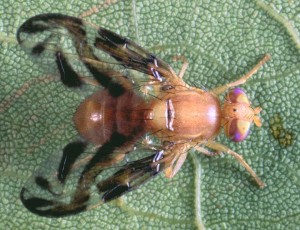
The most serious pest of santol are gall-forming mites. Galls are abnormal outgrowths that form on the leaves as a reaction to the mite infestation. If infected while the plant is young, growth may be severely inhibited. This can also affect fruit production. Infected plants have documented to produce smaller fruits. Infected trees should be sprayed with pesticide when new shoots are about to emerge. Fallen leaves should also be collected and burned.
The Caribbean fruit fly (Anastrepha suspensa) causes freckle-like blemishes on the surface of the fruit. While this does not penetrate the rind, the fruit looks unsightly on the outside and may not seem apt for consumption.
Other insect pests include root grubs, termites, twig borers, beetles, cutworms, mealy bugs, and aphids. Fungi such as Corticium salmonicolor and Phytophthora phaseoli produce wilting and blight on leaves, twigs, and branches.
Harvesting
Trees bear fruit within 5-7 years is sexually propagated and in a much shorter time if asexually propagated. They flower between February to March and the fruits can be harvested by June to October. Fully ripe fruits are yellow to golden brown. They should be allowed to fully ripen on the tree. While full no formal yield record is available, the Yellow variety may produce up to 2,400 fruits.
Fruits are usually eaten fresh. It is fairly nutritious, containing a high amount of ascorbic acid, and a decent amount of carbohydrates, iron, and vitamins.
To consume fresh, the seeds of fresh fruits are sucked like a lollipop. Medical practitioners warn consumers to refrain from swallowing the seed as this can get stuck and have to be removed by surgery. The rind can also be eaten fresh and is normally dipped in salt or other spices.
In India, it is eaten with spices. The rind is made into jam and jelly. Young fruits are candied in Malaysia. In the Philippines, the fruits are peeled chemically. First, the seeds are removed and the rind is boiled with sugar. They are preserved in syrup or processed to marmalade for export. Overripe fruits are fermented with rice to make an alcoholic drink. The rind is also used for dishes in several cultures.
Pests and Diseases
For more plant health information, including diagnostic resources, best-practice pest management advice and plant clinic data analysis for targeted crop protection, visit CABI’s Plantwise Knowledge Bank.
Other Uses
The big canopy makes the santol an excellent shade tree. In the Philippines, it is planted as an ornamental tree in home gardens. The bark is also used in the Philippines to tan fishing lines.
The wood can be used for lumber. It is reddish brown when dry, fairly hard, moderately heavy, close-grained, and polishes well. However, it is not durable when exposed to moisture and it is also subject to borers. On the other hand, it is easy to saw and work and is plentiful in some areas. If seasoned correctly, it can be used for light construction, boats, furniture, utensils, and carvings. When burned, the wood releases an aromatic scent.
Different parts of the tree also have medicinal uses. In Europe, the preserved pulp is used as astringent and crushed leaves are used as poultice for treating rashes. In Java, the root is dried, crushed, and mixed with the bark of Carapa obovata Blume is used to treat vaginal infection such as Leucorrhea. The Philippines, the root and the bark is used as remedy for diarrhea and dysentery. The powdered bark is also used to purge ringworms and added to potions drunk by women after childbirth. Fresh leaves are also boiled and added to baths to reduce fever.
In a study done in Okoyama University and Kyoto Prefectural University of Medicine, the extract from the santol bark was found to be a promising cancer chemo-preventive agent. The active compound called triterpenoid significantly delayed the growth of tumors in two-stage mouse skin. In a separate study done in the University of Illinois, the compound found in santol was cytotoxic to a variety of human cancer cells. Several studies have also been conducted in Japan and India on the possible medicinal uses of extracts from the santol tree.
References:
• Baltazar, L. Success on Second Santol. 13 June 2008. <Retrieved on 10 November 2011 from: http://dessertcomesfirst.com/archives/806/>
• Capetrib Exotic Fruit Farm database. <Retrieved on 4 November 2011 from: http://www.capetrib.com.au/santol.htm>
• Coronel, R.E. Promising Fruits of the Philippines. 1986, University of the Philippines Los Baños, pp. 399-415.
• Ismail, I.S., et. al. Ichthyotoxic and Anticarcinogenic Effects of Triterpenoids from Sandoricum koetjape Bark. Biological and Pharmaceutical Bulletin. September 2003, Vol. 26, No. 2, pp. 1351-1353.
• Kaneda, N., et. al. Plant anticancer agents, L. cytotoxic triterpenes from Sandoricum koetjape stems. Journal of Natural Products. May 1992, Vol. 25, No. 5, pp. 654-659.
• Leyson, O.S., et. al. Swallowed “Santol” Seeds Causing Surgical Abdomen. Medical report for Ospital ng Maynila Medical Center.
• Loha-Unchit, K. Som Tam. 1997. <Retrieved on 10 November 2011 from: http://www.thai-info.net/thaifood/somtam.htm>
• Manomaipiboon, A. M., et. al. Gastrointestinal Complications from Ingested Santol Seeds [abstract]. The Thai Journal of Surgery. 2004, Vol. 25, pp. 91-112.
• Marketman. Santol & Sugpo sa Gata / Santol and Prawns in Coconut Milk. <Retrieved on 4 November 2011 from: http://www.marketmanila.com/archives/santol-sugpo-sa-gata-santol-and-prawns-in-coconut-milk>
• Morton, J. Fruits of Warm Climates. 1987, Miami, Florida, pp. 199-201.
• Roy, A. & S. Saraf. Limonoids: Overview of Significant Bioactive Triterpenes Distributed in Plants Kingdom. Biological and Pharmaceutical Bulletin. February 2006, Vol. 29, No. 2, pp. 191-201.

